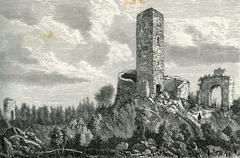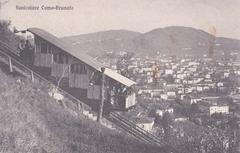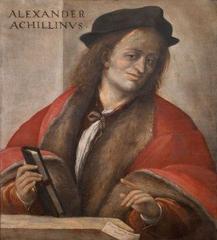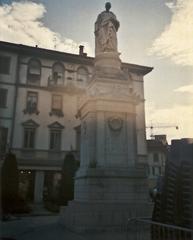Castello della Torre Rotonda: Visiting Hours, Tickets, and Historical Sites in Como
Date: 04/07/2025
Introduction
Situated in the heart of Como, Italy, the Castello della Torre Rotonda is a key emblem of the city’s medieval heritage and ongoing cultural vibrancy. Although much of the original fortress was dismantled in the early 19th century to make way for the neoclassical Teatro Sociale, the site continues to captivate visitors with its historical significance, architectural remnants, and integration into Como’s urban landscape. This guide offers a comprehensive exploration of Castello della Torre Rotonda—from its historic origins and architectural features to practical information on visiting hours, tickets, accessibility, and nearby attractions. Whether you are a history enthusiast, architecture lover, or cultural traveler, this article equips you with all you need for a rewarding visit.
For official updates and further reading, consult archeologicacomo.com, lombardiabeniculturali.it, and Teatro Sociale Como.
Table of Contents
- Introduction
- Historical Overview
- Architectural Features and Legacy
- Visiting Information
- Nearby Attractions and Suggested Itineraries
- FAQs
- Conclusion
- References
Historical Overview
Roman and Early Medieval Origins
Como’s defensive traditions begin with the Roman founding of Novum Comum in 59 BCE, when Julius Caesar ordered the construction of formidable city walls, gates, and towers. These early fortifications laid the groundwork for later medieval expansions and remained integral through successive centuries (archeologicacomo.com).
Rusca Family and Medieval Expansion
Between 1250 and 1285, the influential Rusca family—powerful Ghibelline leaders—commissioned the Castello della Torre Rotonda. Its distinctive round tower was not only a military innovation, offering greater resistance to siege technologies and eliminating blind spots, but also a visible symbol of family prestige and authority. The castle was integrated into Como’s expanded defensive network, which included city walls extending to Lake Como and reinforced moats (it.wikipedia.org).
Visconti and Sforza Influence
In the 14th century, the Visconti dynasty of Milan further fortified the castle, enclosing it within the Cittadella Viscontea, a new walled citadel. Later, under Sforza rule, the castle’s strategic significance diminished, leading to gradual dismantling and privatization of defensive structures (archeologicacomo.com).
Demolition and Modern Transformation
By the early 19th century, the castle was largely demolished to facilitate the construction of the Teatro Sociale (completed in 1813), a neoclassical theater still active today. However, several remnants remain visible—particularly the pointed arch portal, sections of the city walls, and foundations integrated into the theater’s ground floor (lombardiabeniculturali.it).
Architectural Features and Legacy
The Castello della Torre Rotonda’s round tower is a rare example of cylindrical medieval fortification, notable for:
- Thick stone walls: Designed to withstand siege weaponry.
- Narrow windows and elevated entrances: Enhancing defense and surveillance.
- Integration with city walls: Providing a strategic point in Como’s broader fortification system.
Today, the legacy of the castle is preserved in the Teatro Sociale’s structure, the visible medieval walls along Via Grimoldi, and the Gothic portal on Via Virginio Bertinelli. These elements collectively narrate Como’s evolution from a fortified medieval center to a modern cultural hub (lagodicomo.com).
Visiting Information
Location and Access
- Address: Via Bianchi Giovini / Via Virginio Bertinelli, Como, Italy
- Transport: Easily accessible by foot from Como San Giovanni train station; public buses and taxis are readily available. Limited parking is found near the old town.
- Nearby: Piazza Cavour, Como Cathedral (Duomo), Porta Torre
Hours, Tickets, and Accessibility
- Outdoor Remains: The castle’s exterior features (portal, walls) are publicly viewable at all times.
- Teatro Sociale: Generally open Tuesday to Sunday, 10:00 AM–6:00 PM (hours may vary for events; check Teatro Sociale’s website for details).
- Tickets: No tickets required to view exterior remains. Guided tours or entry to interior spaces (such as those incorporated in the Teatro Sociale) may require tickets, typically ranging from €5–€15.
- Accessibility: Teatro Sociale is wheelchair accessible; outdoor areas are mostly accessible, though some cobbled streets may challenge those with limited mobility.
Guided Tours and Special Events
- Guided Tours: Local heritage organizations and the Teatro Sociale offer themed tours focusing on the medieval history and architectural features of the castle. Check availability via the theater’s website or the Como tourist office.
- Events: The Teatro Sociale hosts concerts, performances, and festivals, some of which highlight the castle’s legacy (e.g., the Festival Como Città della Musica in July).
Practical Visitor Tips
- Best Time to Visit: Spring and autumn offer pleasant weather and smaller crowds; early mornings or late afternoons are ideal for photography.
- Languages: Italian predominates, but English is commonly spoken in tourist settings.
- Dress: Comfortable walking shoes recommended; modest attire for visiting religious sites.
- Amenities: Restrooms available in Piazza Cavour and the theater during open hours; numerous cafes and restaurants are nearby.
Nearby Attractions and Suggested Itineraries
- Porta Torre: A striking 12th-century city gate, a short walk from the castle remains (shewandersabroad.com).
- Como Cathedral (Duomo): A grand Gothic-Renaissance cathedral in Piazza Duomo (lakecomotravel.com).
- Old Town: Vibrant streets with shops, cafes, and historic facades (fullsuitcase.com).
- Museums: Civic Art Gallery and Volta Museum offer local art and science exhibits.
- Lakefront Promenade: Ideal for panoramic walks and boat tours.
Suggested Route: Begin at Porta Torre, visit Castello della Torre Rotonda’s remains, continue to the Duomo, and finish at the lakefront for a comprehensive experience of Como’s heritage.
Frequently Asked Questions (FAQ)
Q: What are the visiting hours for Castello della Torre Rotonda?
A: The exterior remains are accessible at all times; access to Teatro Sociale and guided tours follows the theater’s schedule.
Q: Are tickets required?
A: No tickets are needed for outdoor viewing; interior access and tours may require tickets.
Q: Is the site accessible for those with limited mobility?
A: Teatro Sociale is accessible; the surrounding old town is mostly flat but has cobbled streets.
Q: Are guided tours available?
A: Yes, through the theater or local tourism offices. Check current schedules online.
Q: Can I take photographs?
A: Yes, photography is allowed in public areas; respect privacy and event restrictions inside the theater.
Conclusion
Castello della Torre Rotonda encapsulates Como’s layered history—from Roman foundations and medieval power struggles to neoclassical cultural renaissance. While the original fortress no longer stands, its traces in the city’s fabric and the vibrant programming of Teatro Sociale bring the past to life for today’s visitors. Plan your visit to enjoy guided tours, performances, and the architectural beauty of Como’s historic center. For current hours, ticketing, and special events, consult Teatro Sociale Como or the official Visit Como portal. Enhance your exploration with the Audiala app, and immerse yourself in the stories that make Como unforgettable.






